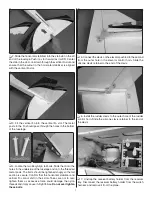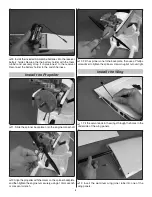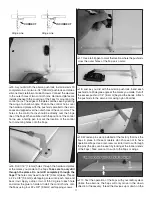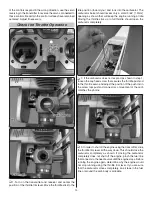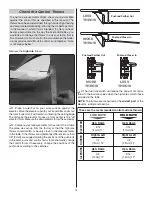
16
Balance the Model Laterally
❏
1. With the wing level, have an assistant help you lift the
model by the engine propeller shaft and the bottom of the
fuse under the TE of the fi n. Do this several times.
❏
2. If one wing always drops when you lift the model, it means
that side is heavy. Balance the airplane by adding weight to the
other wing tip.
An airplane that has been laterally balanced
will track better in loops and other maneuvers.
PREFLIGHT
Identify Your Model
No matter if you fl y at an AMA sanctioned R/C club site or if
you fl y somewhere on your own, you should always have your
name, address, telephone number and AMA number on or
inside your model. It is
required
at all AMA R/C club fl ying sites
and AMA sanctioned fl ying events. Fill out the identifi cation
tag on page 16 and place it on or inside your model.
Balance Propellers
Carefully balance your propeller and spare propellers before
you fl y. An unbalanced prop can be the single most signifi cant
cause of vibration that can damage your model. Not only
will engine mounting screws and bolts loosen, possibly with
disastrous effect, but vibration may also damage your radio
receiver and battery. Vibration can also cause your fuel to
foam, which will, in turn, cause your engine to run hot or quit.
We use a Top Flite Precision Magnetic Prop Balancer
(TOPQ5700) in the workshop and keep a Great Planes
Fingertip Prop Balancer (GPMQ5000) in our fl ight box.
Ground Check
Follow the engine manufacturer’s instructions to break-in
a new engine.
After break-in, confi rm that the engine idles
reliably, transitions smoothly and rapidly to full power and
maintains full power—indefi nitely. After you run the engine on
the model, inspect the model closely to make sure all screws
remained tight, the hinges are secure, the prop is secure and
all pushrods and connectors are secure.
Range Check
Ground check the operational range of your radio before the
fi rst fl ight of the day. Refer to your radio manual for the range
checking procedure of your radio system. During the check,
have an assistant stand by your model and, while you work the
controls, tell you what the control surfaces are doing. Repeat
this test
with the engine running
at various speeds with an
assistant holding the model, using hand signals to show you
what is happening. If the control surfaces do not respond
correctly,
do not fl y!
Find and correct the problem fi rst. Look
for loose servo connections or broken wires, corroded wires
on old servo connectors, poor solder joints in your battery
pack or a defective cell.
ENGINE SAFETY PRECAUTIONS
Failure to follow these safety precautions may result in
severe injury to yourself and others.
●
Keep all engine fuel in a safe place, away from high heat,
sparks or fl ames, as fuel is very fl ammable. Do not smoke
near the engine or fuel; and remember that engine exhaust
gives off a great deal of deadly carbon monoxide. Therefore
do not run the engine in a closed room or garage
.
●
Get help from an experienced pilot when learning to operate
engines.
●
Use safety glasses when starting or running your engine.
●
Do not run the engine in an area of loose gravel or sand;
the propeller may throw such material in your face or eyes.
●
Keep your face and body as well as all spectators away
from the plane of rotation of the propeller as you start and
run the engine.
●
Keep these items away from the prop: loose clothing, shirt
sleeves, ties, scarfs, long hair or loose objects such as
pencils or screwdrivers that may fall out of shirt or jacket
pockets into the prop.
●
Use a “chicken stick” or electric starter to start the engine.
Do not use your fi ngers to fl ip the propeller. Make certain
the glow plug clip or connector is secure so that it will not
pop off or otherwise get into the running propeller.
●
Make all engine adjustments from behind the rotating
propeller.
●
The engine will get hot! Do not touch it during or right after
operation. Make sure fuel lines are in good condition so
fuel will not leak onto a hot engine, causing a fi re.
●
To stop a glow engine, use your radio system to completely
shut the carburetor barrel or if that method fails to work,
cut off the fuel supply by closing off the fuel line. Do not
use hands, fi ngers or any other body part to try to stop
the engine. Do not throw anything into the propeller of a
running engine.






